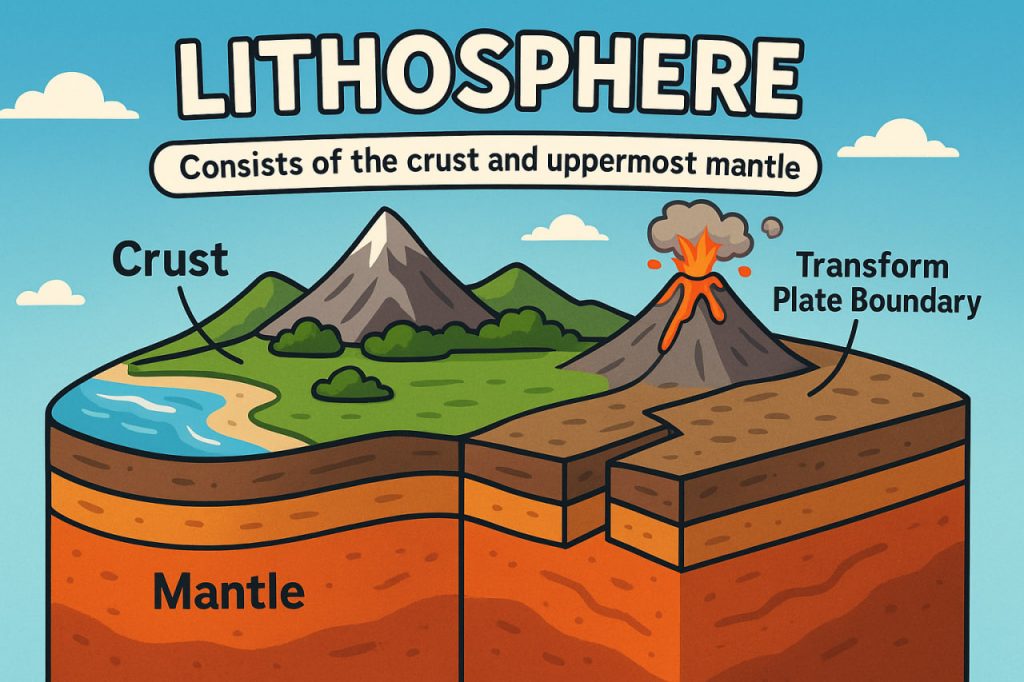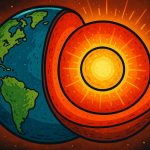The lithosphere is the rigid outer shell of the Earth, encompassing the crust and the uppermost part of the mantle. It plays a critical role in shaping the planet’s surface, influencing geological activity, and supporting life. The lithosphere is divided into large tectonic plates, which move slowly over the softer asthenosphere beneath them, driving processes such as earthquakes, volcanism, and mountain building.
Structure of the Lithosphere
The lithosphere varies in thickness, ranging from about 5–70 kilometers depending on location. It is thinnest beneath ocean basins and thickest beneath continents and mountain ranges. Structurally, it consists of the continental crust — thick, less dense, and mostly made of granite-type rocks — and the oceanic crust, which is thinner, denser, and primarily composed of basalt. Beneath both lies the solid portion of the upper mantle, bonded rigidly to the crust to form the lithosphere.
Tectonic Plates and Their Movement
The lithosphere is broken into several major and minor tectonic plates. These plates float and move over the more ductile asthenosphere due to convection currents in the mantle. Their interactions occur along plate boundaries, which can be convergent (colliding), divergent (moving apart), or transform (sliding past each other). Such movements shape the Earth’s surface and are responsible for much of the planet’s geological activity.
Geological Processes in the Lithosphere
The lithosphere is the stage for many dynamic processes. Volcanic eruptions occur where molten material from the mantle breaches the surface. Earthquakes are caused by the sudden release of stress along faults within or between plates. Mountain ranges form when plates collide, forcing the crust upward. Over millions of years, these processes continually reshape the Earth’s surface.
Importance for Life
The lithosphere provides the foundation for terrestrial ecosystems and is the source of vital natural resources, such as minerals, metals, and fossil fuels. It contains soil layers that support plant life and regulate the cycling of essential elements. The stability and composition of the lithosphere directly affect human habitation and development.
How Scientists Study the Lithosphere
Research into the lithosphere involves seismology, geological mapping, drilling projects, and satellite observations. These methods help scientists understand plate movement, predict earthquakes, and locate valuable resources. Technological advancements have allowed the monitoring of tectonic activity in real time, improving disaster preparedness.
Threats and Human Impact
Human activities such as mining, deforestation, and urban expansion can degrade the lithosphere’s surface, leading to soil erosion, landslides, and loss of biodiversity. Sustainable land use and geological hazard monitoring are essential for preserving the lithosphere’s stability.
Glossary
- Lithosphere – The rigid outer layer of the Earth, consisting of the crust and upper mantle.
- Tectonic plates – Large sections of the lithosphere that move over the asthenosphere.
- Asthenosphere – A semi-fluid layer beneath the lithosphere that allows plate movement.
- Plate boundaries – Zones where tectonic plates meet and interact.
- Seismology – The study of seismic waves to investigate Earth’s internal structure.



I am not very superb with English but I find this real easygoing to understand.